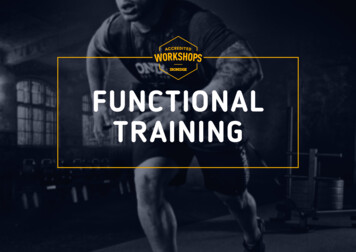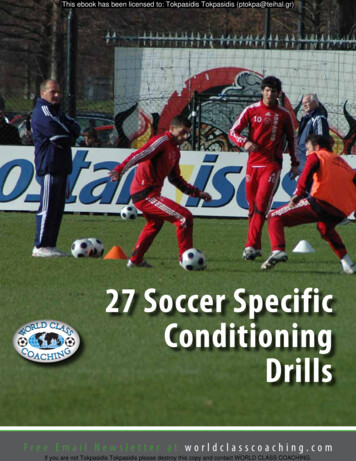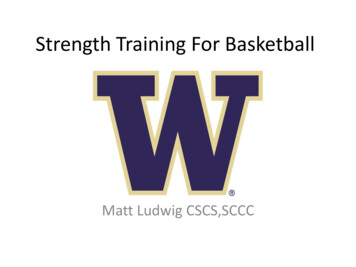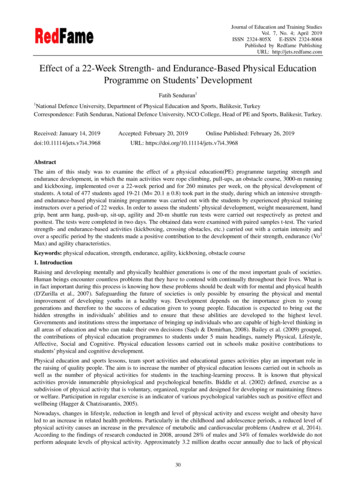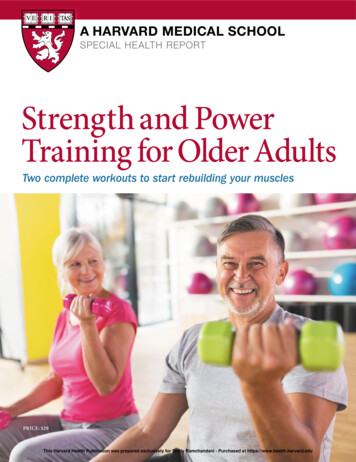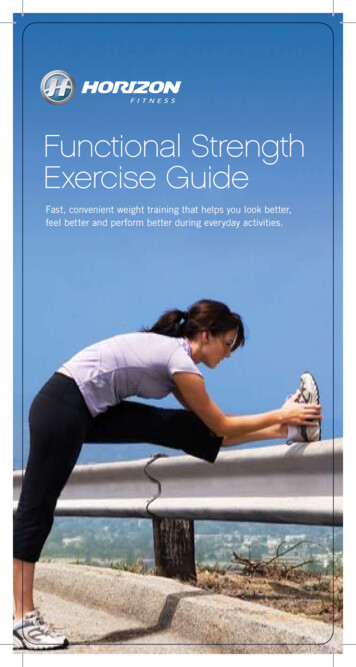
Transcription
Functional Fitness 2017Core Training:Working Hard orHardly Working?Selected Bibliography Functional Training– Juan Carlos Santana Athletic Body in Balance– Gray Cook Low Back Disorders– Stuart McGill Bigger, Faster, Stronger– Mike BoyleWhat is Functional Training?“Function” means different things to different people. There are two goals to “functional training:”improving performance and reducing the risk ofinjury. To start, assess client’s level of functional capacity. Build a foundation of core strength. Add intensity and correct compensations. Find exercises that accelerate and deceleratemovement both with and without resistance. Integrate movements of upper body, lower body andcore.Defining The Core The core is the link between theupper and lower body Generally includes muscles ofthe abdominals, posterior chain,hips, and scapula stabilizers. Inner unit muscles provideisometric support of the spineand limit movement of thetrunk. Outer unit muscles move thespine and provide adequatestability to the vertebral columnwhen under load.The “inner unit” of the core.(C) 2017 by Exercise ETC Inc. All rightsreserved.“Functional Training” is not “Strength Training” Strength Training– Goals are increased strength and/or hypertrophy at aspecific muscle group or joint.– Examples: Pectoral flyes, leg extensions Power Training– Goal is to lift the maximal amount of weight possible by aspecific muscle group or joint.– Examples: Maximal leg press, chest press, power clean Functional Training– Goal is to integrate upper body, lower body and coremuscles to improve performance and lower injury risk.– Examples: Squats, lunges, deadlifts, standing overheadpress, bent over rowsStability vs. Mobility Core stability refers toisometrics holdsmaintaining neutral corealignment in variouspostures Core mobility refers tomaintaining neutral corealignment withconcurrent limbmovement. Both methods require nomovement of the spine1
Functional Fitness 2017Core Stability ResearchCore Stability Research Cont. The core is essentially divided into stabilizers,mobilizers, and load transferring muscles No one group is more important but all arenecessary for injury prevention and proper stability. Lack of recruitment of stabilizers(diaphragm,multifidus, TVA, pelvic floor muscles ) at theinitiation of movement is often found in thedeconditioned and those with LBP. This prevents adequate spinal stability and properproprioception Sports Health 2013“To Core or Not To Core”Indiana State University, 2011 Core trainingfor highlyconditionedathletes didNOT improveperformanceOR reduceinjury rate. Core trainingfordeconditionedor recreationalathletesimprovedperformanceAND reducedinjury rate.Working Hard?Hardly Working? Prolonged isometric holds lead to a rapid lossof oxygen to core muscles. Try to achieve muscle fatigue (quivering)within 8 – 10 seconds to build core power. Short rests between holds allow the muscleto restore oxygen. Ergonomics,2010(C) 2017 by Exercise ETC Inc. All rightsreserved. A complete coretraining program mustinclude:– Core stabilityassessment– Neuromuscular controland proper musclerecruitment patterns– Muscular strength,endurance, and powerdevelopmentThe Foundation:Planks, Bridges, Side Planks, QuadrupedsAssessing the CoreCan client hold each position for 20 ‐ 60 seconds? Anti Extension– Front Plank Anti‐Flexion– Two Foot Bridge– Unilateral Bridge Anti Lateral Flexion– Side bridge, each side Anti Rotation– Bird Dog2
Functional Fitness 2017How Do We Progress the Core? Resisted & Multi‐plane CoreResisted CoreMulti‐plane CoreVertical CoreDynamic CoreCardio CorePredictive CoreReactive CoreAnti‐Flexion Exercise:Bridge With Core ActivationAnti Extension Exercise:3 Point RowAnti Rotation Exercise:MB Plank RollSide Plank Rows & Presses(C) 2017 by Exercise ETC Inc. All rightsreserved.3
Functional Fitness 2017Band Resisted Side PlankBand Resisted Side Plank with Balloon TapVertical Core Once proper stability isattained the goal is toimprove strength andpower. Total body strength islimited when the corecannot support it. Power is essential forathletic performanceand activities of dailyliving.Partnered (or Cable) Push PullStanding Anti Flexion PressStanding Anti Extension PressStanding Anti Lateral Flexion Press These drills will mainlychallenge the core inthe frontal plane. The goal is to see nolateral movement of thespine.(C) 2017 by Exercise ETC Inc. All rightsreserved.4
Functional Fitness 2017Cardio CoreDynamic CoreReactive CoreProceed With CautionCore Power Training Exercises Goal is to focus onquality movement withhigh velocities. Since velocity is theprimary goal, resistanceused should be low. For MB exercises 4‐8lbsis recommended.Band Press With Forward Lunge In order to progress to these exercises, clients mustdemonstrate adequate postural stability andfoundational core movements. Before attempting these exercises assess foradequate core stability AND proper hip and thoracicspine rotation. Assess progress properly to avoid injuries andmovement dysfunctions.Band Row With Reverse Lunge(C) 2017 by Exercise ETC Inc. All rightsreserved.Anti Rotation Side Shuffle5
Functional Fitness 2017Band Rotation With PivotMonster Band Speed HopsMonster Band Lateral Hop and StickMB Overhead ThrowsKneeling ChopsRotational ThrowsMonster Band Battles,Bosu Med Ball TossTry this on anunstable surface, too!(C) 2017 by Exercise ETC Inc. All rightsreserved.6
Find exercises that accelerate and decelerate movement both with and without resistance. Integrate movements of upper body, lower body and core. "Functional Training" is not "Strength Training" Strength Training - Goals are increased strength and/or hypertrophy at a specific muscle group orjoint.
